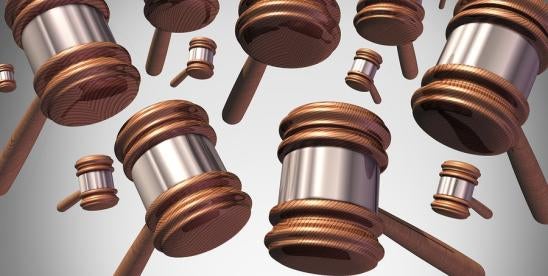A flurry of activity from various courts this past week on “exceptional cases” under Section 285 of the Patent Act provided notable guidance for practitioners and patent owners, with a particular emphasis on the motivation and conduct of the litigants. We provide a short synopsis of these cases.
By way of context, in 2014, the Supreme Court in Octane Fitness, LLC v. ICON Health & Fitness, Inc., 134 S. Ct. 1749 (2014), instructed courts to apply a totality of the circumstances test when evaluating whether a case is “exceptional” under 35 U.S.C. § 285. If a case is found to be exceptional within the meaning of the statute, monetary sanctions and fee-shifting may be imposed. This totality of the circumstances analysis was a substantial departure from the previous Federal Circuit tests, which were uniformly viewed as more rigid. Some of the factors the Supreme Court suggested district courts could consider included “frivolousness, motivation, objective unreasonableness (both in the factual and legal components of the case) and the need in particular circumstances to advance considerations of compensation and deterrence.” Our previous discussion of exceptional cases under Section 285 can be found here.
The motivation of the litigants and the conduct of the losing party during the course of litigation have become the recent focal points for evaluating exceptional cases, including in the following quartet of recent cases:
Checkpoint Systems v. All-Tag Security (Fed. Cir.)
In the first of two decisions from the Federal Circuit handed down on June 5, 2017, the court reversed a finding of an exceptional case from the Eastern District of Pennsylvania. After a jury verdict finding the one patent-in-suit not infringed, invalid, and unenforceable, the district court found the case to be exceptional. It then awarded the defendants approximately $6.6 million in attorneys’ fees. The district court’s finding of an exceptional case was based on findings that the plaintiff:
-
Conducted an inadequate pre-suit investigation relying on an examination of the accused infringer’s Swiss-made products while the accused products were Belgian-made;
-
Improperly relied on a European infringement verdict against the defendant on a counterpart patent and two infringement opinions from counsel that “were given years before filing;” and
-
Had an “improper [litigation] motivation” because the suit was filed “to interfere improperly with Defendants’ business and to protect its own competitive advantage.”
Writing for the unanimous Federal Circuit panel, Judge Newman dismissed each of these points and reversed the lower court’s decision as an abuse of discretion. As to the plaintiff’s pre-filing investigation, the Federal Circuit found no evidence that the examined Swiss products were different than the accused Belgian products. Moreover, the plaintiff survived summary judgment motions and a Daubert challenge on these products. According to the Federal Circuit, this demonstrated that the plaintiff’s claims were objectively reasonable.
The court also rejected the “improper motivation” rationale. Although the district court cited the plaintiff’s lawsuits against other accused infringers, its market share, and its acquisition of competing producers as purported evidence of an improper motive, the Federal Circuit concluded this was insufficient for finding the case exceptional. The court said “motivation to implement the statutory patent right by bringing suit based on a reasonable belief in infringement is not an improper motive. A patentee’s assertion of reasonable claims of infringement is the mechanism whereby patent systems provide an innovation incentive.”
The opinion can be found here: Checkpoint Sys. Inc. v. All-Tag Sec. S.A., No. 16-1397 (Fed. Cir. June 5, 2017)
Rothschild Connected Devices Innovations v. Guardian Protection Services (Fed. Cir.)
By contrast, the second Federal Circuit opinion from June 5th concluded that the district court abused its discretion by not finding a case exceptional under Section 285. Shortly after the plaintiff filed suit in the Eastern District of Texas, the defendant moved for judgment on the pleadings asserting the patent claimed ineligible subject matter under 35 U.S.C. § 101. The defendant also sent the plaintiff a Safe Harbor notice under Rule 11 for a proposed motion for sanctions, which included purportedly invalidating prior art under § 102. The plaintiff promptly moved to dismiss the action, and the defendant moved for attorneys’ fees under Section 285. The district court determined the case was not exceptional under Section 285 because:
-
The plaintiff voluntarily withdrew the complaint after receiving the Rule 11 Safe Harbor notice;
-
The defendant neither filed a motion seeking to invalidate the patent under Section 102 nor demonstrated that the plaintiff failed to conduct a reasonable pre-suit investigation of the prior art; and
-
Although the plaintiff had filed “over fifty other lawsuits” in the same district on the same patent, the court rejected the defendant’s assertion that the plaintiff did not intend to test the merits of its claim and was merely seeking to obtain nuisance-value settlements.
The Federal Circuit reversed the lower court for several reasons.
First, the district court “conflated” Rule 11 and Section 285 by finding that Section 285 should not be applied where the plaintiff had voluntarily withdrawn the complaint in response to a Rule 11 challenge. The Federal Circuit, citing to Octane Fitness, concluded that “a district court may award fees in the rare case in which a party’s unreasonable conduct—while not necessarily independently sanctionable—is nonetheless so ‘exceptional’ as to justify an award of fees.”
Second, the district court improperly relied on affidavits from both the plaintiff’s counsel and its founder in an attempt to show reasonable pre-suit investigation, which purported to establish that the plaintiff had a “good faith” belief the patent was valid, failed to provide any analysis of how the patent was valid in view of the defendant’s Rule 11 allegation. The Federal Circuit found these affidavits to be “conclusory and unsupported” and thus entitled to no evidentiary value, and ultimately the plaintiff was “willfully ignorant” of the asserted prior art.
Third, the district court “misjudged” plaintiff’s conduct in other litigations. The district court had improperly relied on the same affidavits from plaintiff’s counsel and its founder in attempting to demonstrate reasonable conduct. The Federal Circuit, finding no other evidence in the record to show any reasonable conduct by the plaintiff and found plaintiff’s litigation conduct, including its pattern of filing suits, to be vexatious. The court reversed and remanded for a calculation of attorneys’ fees.
Rothschild Connected Devices Innovations LLC v. Guardian Prot. Servs. LLC, No. 16-2521 (Fed. Cir. June 5, 2017).
SRI International v. Cisco (D. Del.)
The District of Delaware also weighed in with an opinion regarding section 285 on June First. In SRI International v. Cisco, the court found that the defendant’s conduct during litigation, along with the jury’s finding of willful infringement, warranted a conclusion of exceptionality under Section 285. The jury determined the defendant Cisco infringed the patents-in-suit, awarded damages in excess of $23 million, and made a finding of willful infringement. The plaintiff SRI then moved for attorneys’ fees under Section 285.
Judge Robinson found that the defendant “created a substantial amount of work for both [the plaintiff] and the court, much of which work was needlessly repetitive or irrelevant or frivolous.” A laundry list of findings supported the “unreasonable manner” in which the case was litigated, including:
-
The defendant maintained its reliance on 19 invalidity theories until the eve of trial but at trial only presented a single defense of anticipation and a single claim of invalidity under § 112.
-
The single prior art reference the defendant advanced at trial had twice been considered by the PTO and by the district court in a prior litigation.
-
The defendant’s non-infringement position relied on a claim interpretation that contradicted the Court’s claim constructions and its own internal documentation
-
The defendant designated 53 separate transcripts consisting of nearly 48,000 lines of testimony (which required the plaintiff to review for objections and counter-designations) while affirmatively presenting only 22 lines of testimony from a single transcript at trial
For these reasons, and because the jury found willful infringement, the court found the case exceptional and awarded attorneys’ fees and costs of approximately $8 million.
The case is: SRI Int’l, Inc. v. Cisco Sys., No. 13-1534 (D. Del. June 1, 2017).
Large Audience Display v. Tennman Productions (E.D. Tex.)
Finally, on June 7, 2017, Judge Manuel Real in the Central District of California awarded over $700,000 in attorneys’ fees under Section 285 after a multi-year dispute on the issue. The district court originally found the case was exceptional in August 2015 after a parallel reexamination proceeding canceled all of the claims in the patent-at-issue and judgment was entered against the plaintiff. The court granted an award of the full amount of attorneys’ fees requested, which was later reversed and remanded by the Federal Circuit.
On remand, the district court again found the case exceptional. Large Audience Display Sys., LLC v. Tennman Prods., LLC, No. 11-3398 (C.D. Cal. Apr. 10, 2017). The Court found that:
-
The plaintiff was formed in order to defeat a change of venue and keep the case in the Eastern District of Texas. The patent-at-issue was previously owned by a California entity. Two days before filing the suit, the plaintiff formed as a corporate entity in Texas and transferred the patent. A year later, the plaintiff failed to pay taxes due on the corporate entity, and it ceased to exist. “This type of litigation gamesmanship stands out from the ordinary case and necessitated significant work by Defendants in response.”
-
The claim construction positions taken by the plaintiff during the parallel reexamination proceeding were “objectively weak.” In particular, the court found plaintiff’s positions were “plainly contradicted” on the face of the patent.
-
The plaintiff also attempted to use a privileged email chain inadvertently sent from defendant’s counsel to plaintiff’s counsel. Plaintiff did not notify defendant of the inadvertent production when it occurred. Instead, plaintiff used it as evidence in opposition to defendant’s motion for attorneys’ fees, which is when defendant first learned of the inadvertent production.
The court again ordered nearly the entire full amount of over $700,000 in attorneys’ fees. The plaintiff attempted to limit the portion of the award to only compensate for the extra legal expense caused by the litigation misconduct, but the district court found that argument unpersuasive. The court reiterated that “Plaintiff’s misconduct permeated throughout the entirety of this matter.”
The case is: Large Audience Display Systems, LLC v. Tennman Productions, LLC, et. al., No. 2-11-cv-03398 (C.D. Cal. June 2, 2017).
General guidance may be difficult to derive from these cases, as Section 285 analysis is necessarily fact-intensive and case-specific. However, it is clear that, in applying Octane Fitness, courts are properly scrutinizing the entire factual record. Notably, this includes looking beyond the party’s conduct in the immediate litigation. Parties looking to recover attorneys’ fees under Section 285 should look for any facts that make the case “unusual” enough as to warrant fee-shifting. On the other hand, patent holders should ensure that their litigation conduct in all matters is above-board.




 i
i

